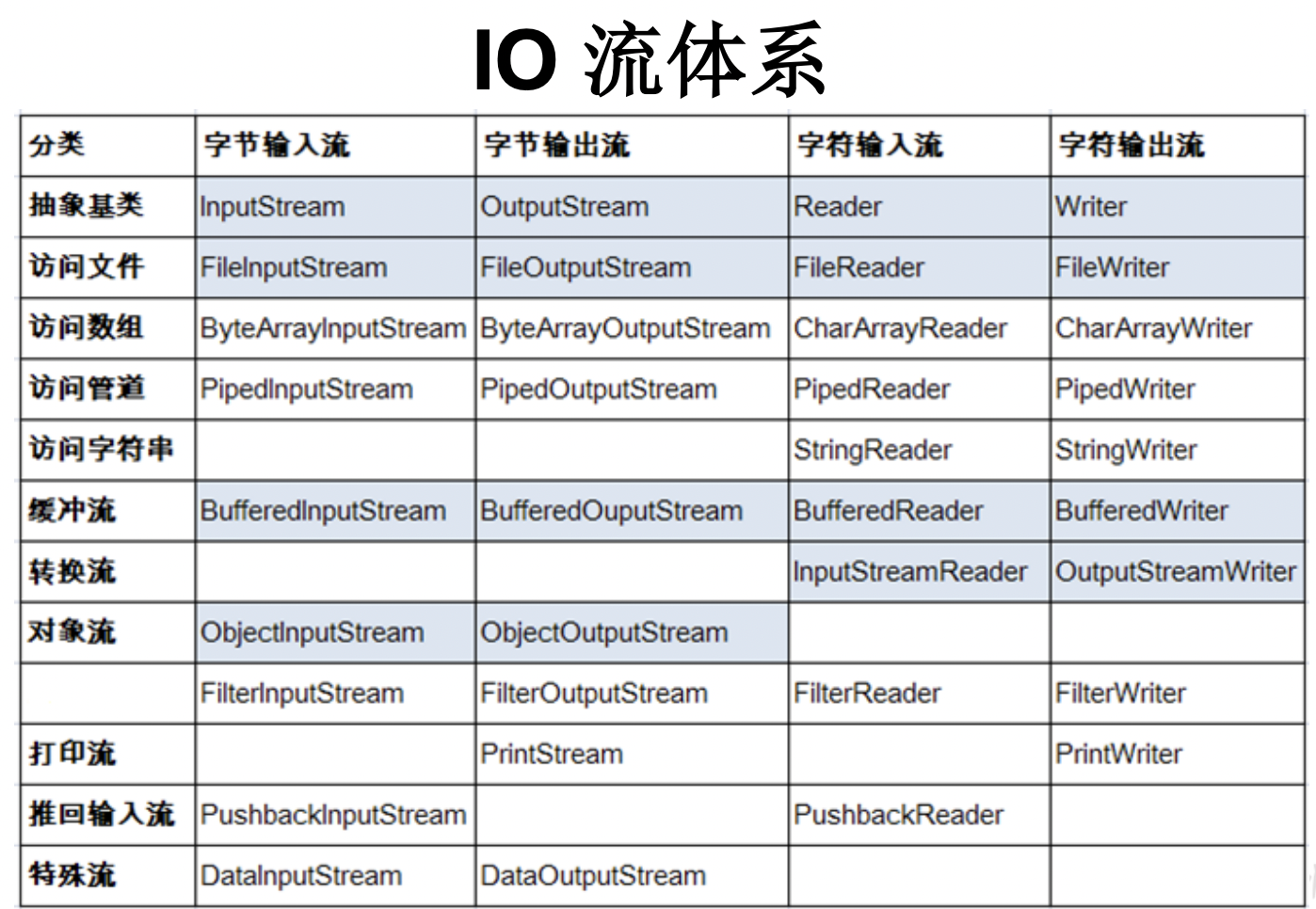File类
- File类的一个对象,代表一个文件或一个文件目录(俗称:文件夹)。
- File类声明在java.io包下。
- File类中涉及到关于文件或文件目录的创建、删除、重命名、修改时间、文件大小等方法,并未涉及到写入或读取文件内容的操作。如果需要读取或写入文件内容,必须使用IO流来完成。
后续File类的对象常会作为参数传递到流的构造器中,指明读取或写入的”终点”.
常用构造器
public File(String pathname)以pathname为路径创建File对象,可以是绝对路径或者相对路径,如果 pathname是相对路径(在project中,相对路径的根目录是project的根文件夹),则默认的当前路径在系统属性user.dir中存储。public File(String parent,String child)以parent为父路径,child为子路径创建File对象。public File(File parent,String child)根据一个父File对象和子文件路径创建File对象。 ```java //构造器1 File file1 = new File(“hello.txt”);//相对于当前module File file2 = new File(“D:\workspace_idea1\JavaSenior\day08\he.txt”);
System.out.println(file1); System.out.println(file2);
//构造器2: File file3 = new File(“D:\workspace_idea1”,”JavaSenior”); System.out.println(file3);
//构造器3: File file4 = new File(file3,”hi.txt”); System.out.println(file4);
<a name="PVrl2"></a>## 常用方法<a name="WvHnw"></a>### 获取功能- `public String getAbsolutePath()`:获取绝对路径- `public String getPath() `:获取路径- `public String getName() `:获取名称- `public String getParent()`:获取上层文件目录路径。若无,返回null- `public long length()` :获取文件长度(即:字节数)。不能获取目录的长度。- `public long lastModified()` :获取最后一次的修改时间,毫秒值如下的两个方法适用于文件目录:- `public String[] list()` :获取指定目录下的所有文件或者文件目录的名称数组- `public File[] listFiles()` :获取指定目录下的所有文件或者文件目录的File数组```javaFile file = new File("D:\\workspace_idea1\\JavaSenior");String[] list = file.list();for(String s : list){System.out.println(s);}System.out.println();File[] files = file.listFiles();for(File f : files){System.out.println(f);}
重命名功能
public boolean renameTo(File dest):把文件重命名为指定的文件路径。
比如:file1.renameTo(file2)为例:要想保证返回true,需要file1在硬盘中是存在的,且file2不能在硬盘中存在。
判断功能
public boolean isDirectory():判断是否是文件目录public boolean isFile():判断是否是文件public boolean exists():判断是否存在public boolean canRead():判断是否可读public boolean canWrite():判断是否可写public boolean isHidden():判断是否隐藏
创建功能
public boolean createNewFile():创建文件。若文件存在,则不创建,返回false.public boolean mkdir():创建文件目录。如果此文件目录存在,就不创建了。如果此文件目录的上层目录不存在,也不创建。public boolean mkdirs():创建文件目录。如果此文件目录存在,就不创建了。如果上层文件目录不存在,一并创建.
删除磁盘中的文件或文件目录
public boolean delete():删除文件或者文件夹
删除注意事项:Java中的删除不走回收站。
IO流
Java IO原理
- I/O是Input/Output的缩写, I/O技术是非常实用的技术,用于处理设备之间的数据传输,如读/写文件,网络通讯等。
- Java程序中,对于数据的输入/输出操作以“流(stream)” 的方式进行。
- java.io包下提供了各种“流”类和接口,用以获取不同种类的数据,并通过标准的方法输入或输出数据。
流的分类
- 按操作数据单位不同分为:字节流(8 bit),字符流(16 bit) 。
- 按数据流的流向不同分为:输入流,输出流。
- 按流的角色的不同分为:节点流(文件流),处理流。
- 节点流:可以从特定数据源读写数据,如FileReader、FileWriter。
- 处理流:是对一个已存在的流的连接和封装,通过所封装的流的功能调用实现数据读写。

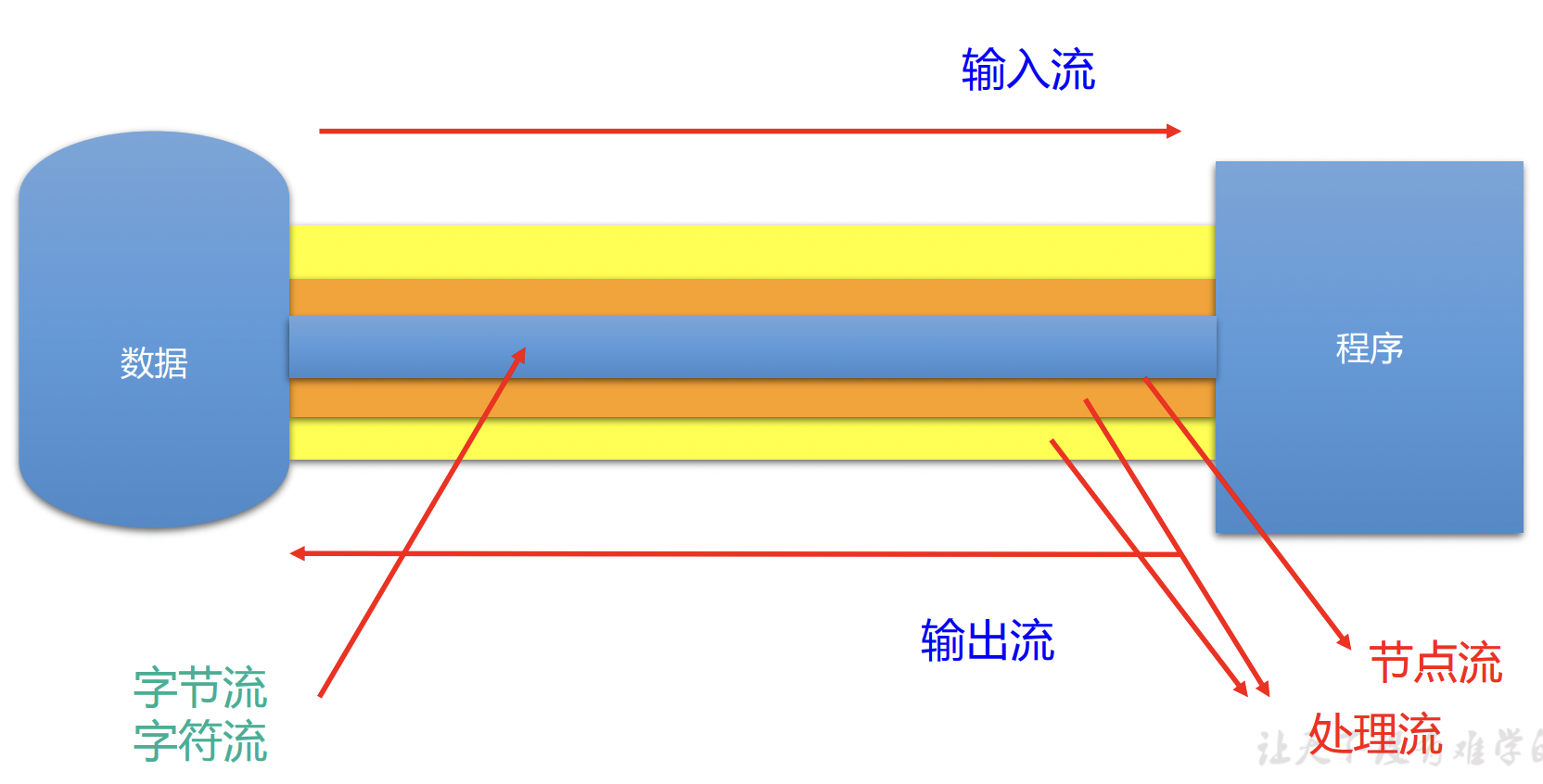
流的体系
节点流(文件流)
对于文本文件(.txt,.java,.c,.cpp),使用字符流处理,非文本文件(.jpg,.mp3,.mp4,.avi,.doc,.ppt,…),使用字节流处理。具体的操作流程都类似,只需根据不同的文件类型选取相应的函数即可。
⚠️如果用字节流处理文本文件可能会出现乱码。 https://blog.csdn.net/weixin_44720982/article/details/124314583
- 读取文件
- read()的理解:返回读入的一个字符。如果达到文件末尾,返回-1。
- 异常的处理:为了保证流资源一定可以执行关闭操作。需要使用try-catch-finally处理。
- 读入的文件一定要存在,否则就会报FileNotFoundException。

@Test
public void testFileReader() {
FileReader fr = null;
try {
//1.File类的实例化
File file = new File("hello.txt");
//2.FileReader流的实例化
fr = new FileReader(file);
//3.读入的操作
//read(char[] cbuf):返回每次读入cbuf数组中的字符的个数。如果达到文件末尾,返回-1
char[] cbuf = new char[5]; //cbuf:charbuffer
int len;
while((len = fr.read(cbuf)) != -1){
//方式一:
//错误的写法
// for(int i = 0;i < cbuf.length;i++){
// System.out.print(cbuf[i]);
// }
//正确的写法
// for(int i = 0;i < len;i++){
// System.out.print(cbuf[i]);
// }
//方式二:
//错误的写法,对应着方式一的错误的写法
// String str = new String(cbuf);
// System.out.print(str);
//正确的写法
String str = new String(cbuf,0,len);
System.out.print(str);
}
} catch (IOException e) {
e.printStackTrace();
} finally {
if(fr != null){
//4.资源的关闭
try {
fr.close();
} catch (IOException e) {
e.printStackTrace();
}
}
}
}
- 写入文件
- 输出操作,对应的File可以不存在的。并不会报异常。
- File对应的硬盘中的文件如果不存在,在输出的过程中,会自动创建此文件。
File对应的硬盘中的文件如果存在:
- 如果流使用的构造器是:FileWriter(file,false) / FileWriter(file):对原有文件的覆盖。
如果流使用的构造器是:FileWriter(file,true):不会对原有文件覆盖,而是在原有文件基础上追加内容。 ```java @Test public void testFileWriter() { FileWriter fw = null; try { //1.提供File类的对象,指明写出到的文件 File file = new File(“src/IO/hello.txt”);
//2.提供FileWriter的对象,用于数据的写出 fw = new FileWriter(file,true);
//3.写出的操作 fw.write(“I have a dream!\n”); fw.write(“you need to have a dream!\n”); } catch (IOException e) { e.printStackTrace(); } finally { //4.流资源的关闭 if(fw != null){
try { fw.close(); } catch (IOException e) { e.printStackTrace(); }} }
}
- **文件复制**
1. 文本文件字符流复制。
```java
@Test
public void testFileReaderFileWriter() {
FileReader fileReader = null;
FileWriter fileWriter = null;
try {
File file = new File("src/IO/hi.txt");
File copyFile = new File("src/IO/copy_hi.txt");
fileReader = new FileReader(file);
fileWriter = new FileWriter(copyFile, true);
char[] cbuf = new char[5];
int len;
while ((len = fileReader.read(cbuf)) != -1) {
fileWriter.write(cbuf, 0, len);
}
} catch (IOException e) {
e.printStackTrace();
} finally {
if (fileReader != null) {
try {
fileReader.close();
} catch (IOException e) {
e.printStackTrace();
}
}
if (fileWriter != null) {
try {
fileWriter.close();
} catch (IOException e) {
e.printStackTrace();
}
}
}
}
非文本文件(.jpg,.mp3,.mp4,.avi,.doc,.ppt,…)字节流复制。 ```java public void copyFile(String srcPath,String destPath){ FileInputStream fis = null; FileOutputStream fos = null; try {
//造文件 File srcFile = new File(srcPath); File destFile = new File(destPath); //造流 fis = new FileInputStream(srcFile); fos = new FileOutputStream(destFile); //复制的过程 byte[] buffer = new byte[1024]; int len; while((len = fis.read(buffer)) != -1){ fos.write(buffer,0,len); }} catch (IOException e) {
e.printStackTrace();} finally {
if(fos != null){ // try { fos.close(); } catch (IOException e) { e.printStackTrace(); } } if(fis != null){ try { fis.close(); } catch (IOException e) { e.printStackTrace(); } }} }
@Test public void testCopyFile(){
long start = System.currentTimeMillis();
String srcPath = "C:\\Users\\Administrator\\Desktop\\01-视频.avi";
String destPath = "C:\\Users\\Administrator\\Desktop\\02-视频.avi";
// String srcPath = "hello.txt";
// String destPath = "hello3.txt";
copyFile(srcPath,destPath);
long end = System.currentTimeMillis();
System.out.println("复制操作花费的时间为:" + (end - start));//618
}
<a name="D7PBR"></a>
###
<a name="I8Qs7"></a>
### 缓冲流
提升流的读取、写入的速度(内部提供了一个缓冲区�)。
- **文件复制**
1. 文本文件复制。
```java
@Test
public void testBufferedReaderBufferedWriter(){
BufferedReader br = null;
BufferedWriter bw = null;
try {
//创建文件和相应的流
br = new BufferedReader(new FileReader(new File("dbcp.txt")));
bw = new BufferedWriter(new FileWriter(new File("dbcp1.txt")));
//读写操作
//方式一:使用char[]数组
// char[] cbuf = new char[1024];
// int len;
// while((len = br.read(cbuf)) != -1){
// bw.write(cbuf,0,len);
// // bw.flush();
// }
//方式二:使用String
String data;
while((data = br.readLine()) != null){
//方法一:
// bw.write(data + "\n");//data中不包含换行符
//方法二:
bw.write(data);//data中不包含换行符
bw.newLine();//提供换行的操作
}
} catch (IOException e) {
e.printStackTrace();
} finally {
//关闭资源
if(bw != null){
try {
bw.close();
} catch (IOException e) {
e.printStackTrace();
}
}
if(br != null){
try {
br.close();
} catch (IOException e) {
e.printStackTrace();
}
}
}
}
�
非文本文件复制。
public void copyFileWithBuffered(String srcPath,String destPath){ BufferedInputStream bis = null; BufferedOutputStream bos = null; try { //1.造文件 File srcFile = new File(srcPath); File destFile = new File(destPath); //2.造流 //2.1 造节点流 FileInputStream fis = new FileInputStream((srcFile)); FileOutputStream fos = new FileOutputStream(destFile); //2.2 造缓冲流 bis = new BufferedInputStream(fis); bos = new BufferedOutputStream(fos); //3.复制的细节:读取、写入 byte[] buffer = new byte[1024]; int len; while((len = bis.read(buffer)) != -1){ bos.write(buffer,0,len); } } catch (IOException e) { e.printStackTrace(); } finally { //4.资源关闭 //要求:先关闭外层的流,再关闭内层的流 if(bos != null){ try { bos.close(); } catch (IOException e) { e.printStackTrace(); } } if(bis != null){ try { bis.close(); } catch (IOException e) { e.printStackTrace(); } } //说明:关闭外层流的同时,内层流也会自动的进行关闭。关于内层流的关闭,我们可以省略. // fos.close(); // fis.close(); } }转换流
提供了在字节流和字符流之间的转换。
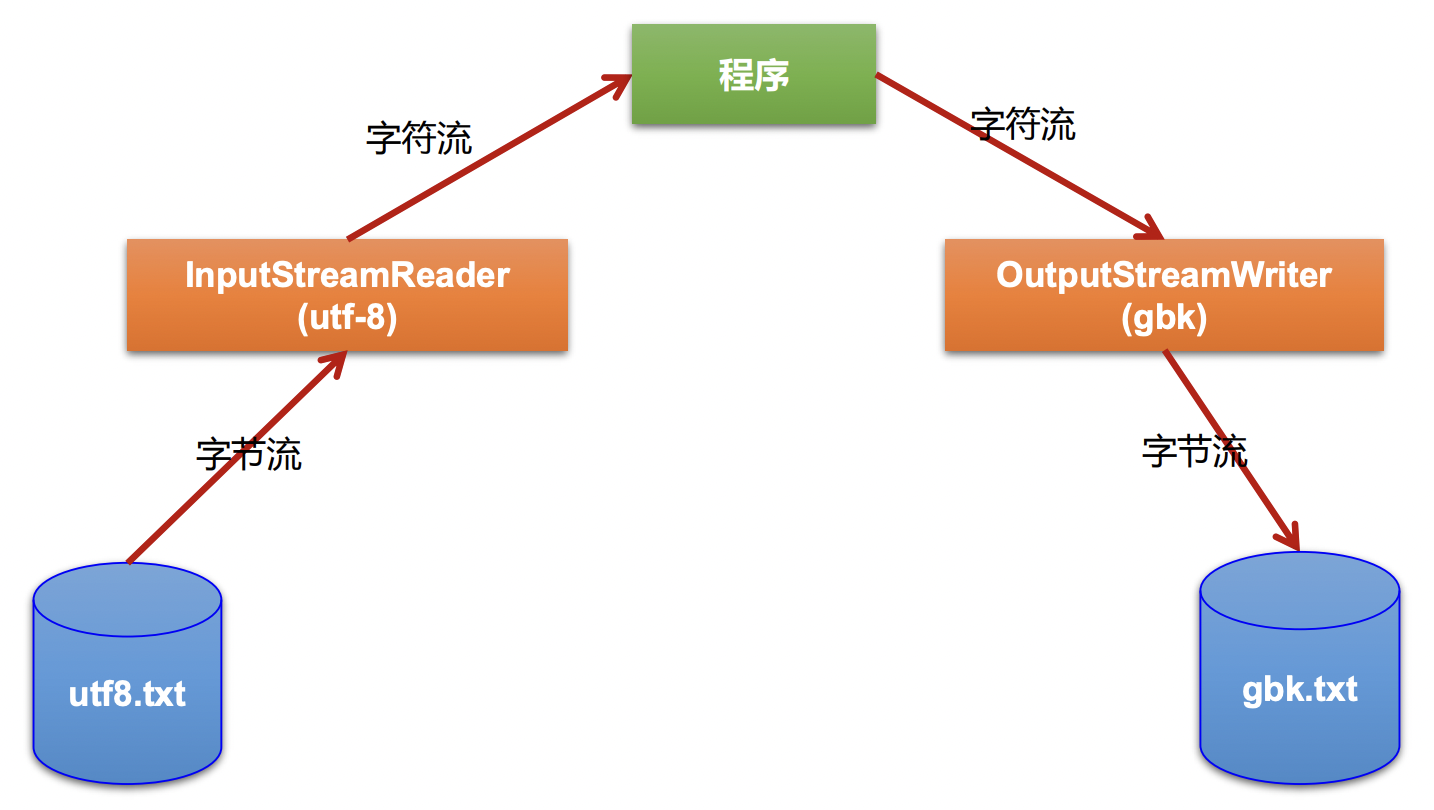
- 解码:字节、字节数组 —->字符数组、字符串
编码:字符数组、字符串 —-> 字节、字节数组 - 字符集
https://www.bilibili.com/video/BV1Kb411W75N?p=602&share_source=copy_web
- ASCII:美国标准信息交换码。用一个字节的7位可以表示。
- ISO8859-1:拉丁码表。欧洲码表用一个字节的8位表示。
- GB2312:中国的中文编码表。最多两个字节编码所有字符。
- GBK:中国的中文编码表升级,融合了更多的中文文字符号,最多两个字节编码
- Unicode:国际标准码,融合了目前人类使用的所有字符,为每个字符分配唯一的字符码,所有的文字都用两个字节来表示。
- UTF-8:变长的编码方式,可用1-4个字节来表示一个字符。

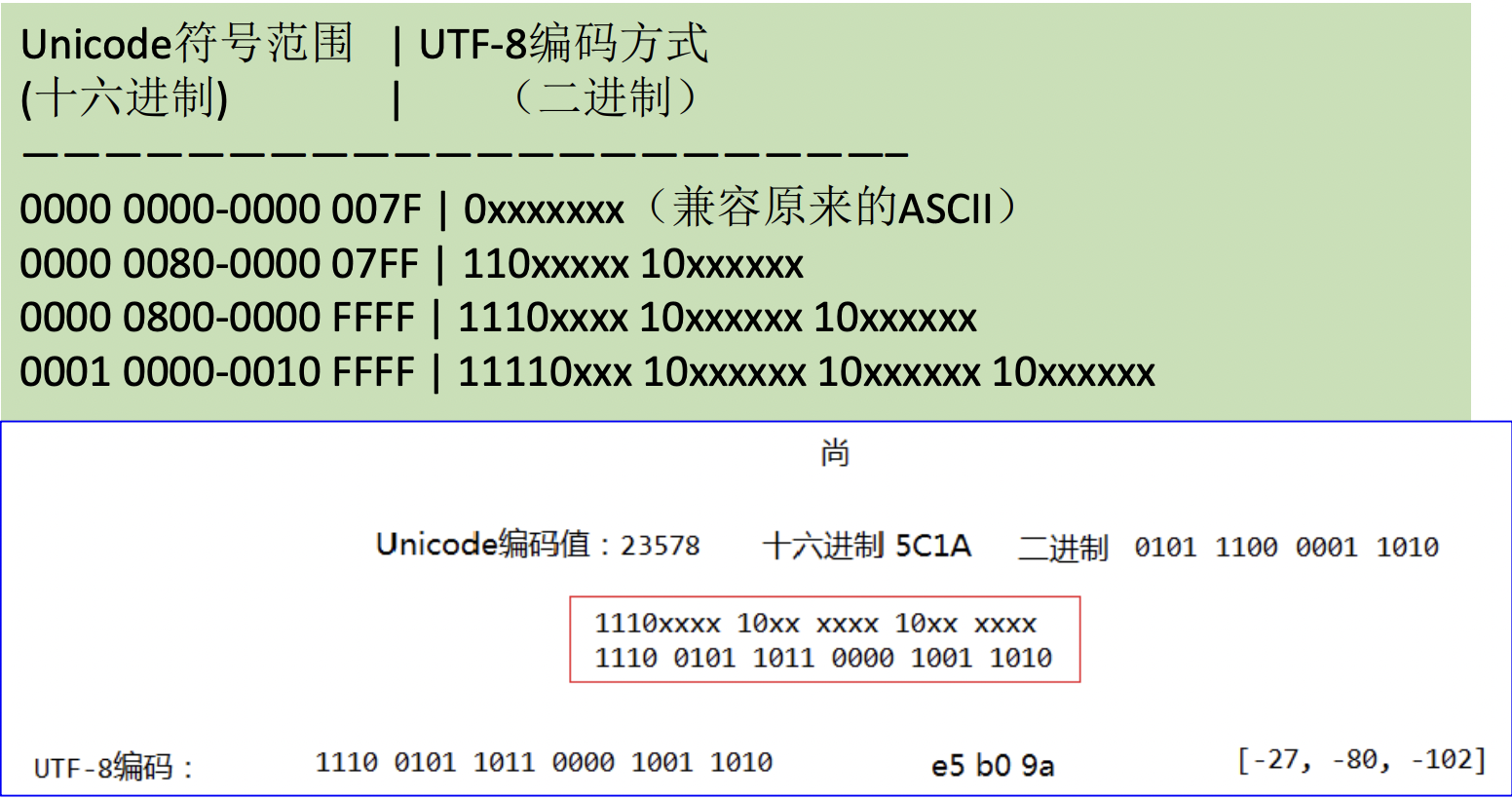
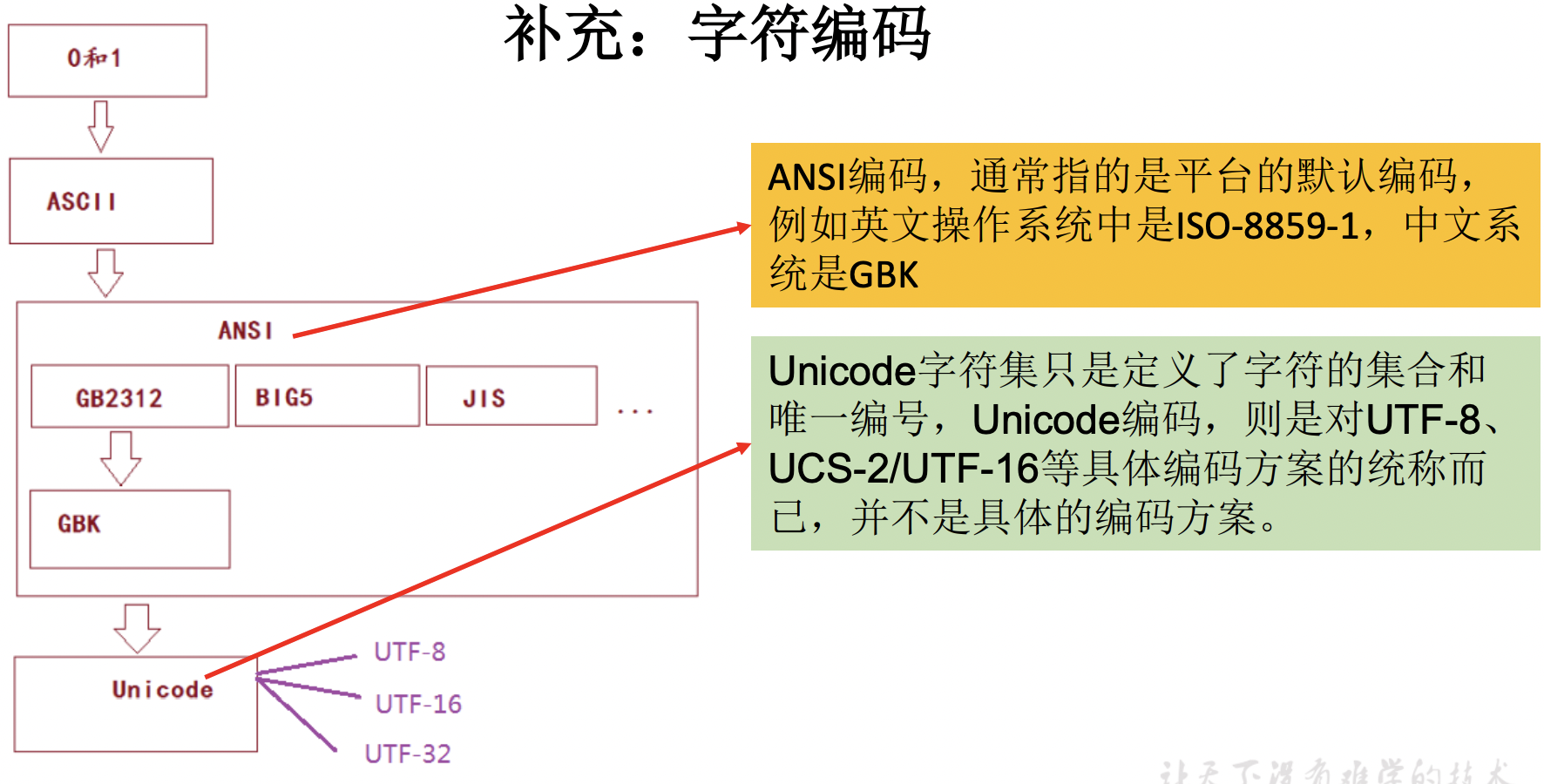
/*
此时处理异常的话,仍然应该使用try-catch-finally
综合使用InputStreamReader和OutputStreamWriter
*/
@Test
public void test2() throws Exception {
//1.造文件、造流
File file1 = new File("dbcp.txt");
File file2 = new File("dbcp_gbk.txt");
FileInputStream fis = new FileInputStream(file1);
FileOutputStream fos = new FileOutputStream(file2);
InputStreamReader isr = new InputStreamReader(fis,"utf-8");
OutputStreamWriter osw = new OutputStreamWriter(fos,"gbk");
//2.读写过程
char[] cbuf = new char[20];
int len;
while((len = isr.read(cbuf)) != -1){
osw.write(cbuf,0,len);
}
//3.关闭资源
isr.close();
osw.close();
}
(了解)标准输入、输出流
System.in:标准的输入流,默认从键盘输入。System.out:标准的输出流,默认从控制台输出。System类的
setIn(InputStream is) / setOut(PrintStream ps)方式重新指定输入和输出的流。� ```java /*练习: 从键盘输入字符串,要求将读取到的整行字符串转成大写输出。然后继续进行输入操作, 直至当输入“e”或者“exit”时,退出程序。方法一:使用Scanner实现,调用next()返回一个字符串 方法二:使用System.in实现。System.in —-> 转换流 —-> BufferedReader的readLine()*/
BufferedReader br = null; try { InputStreamReader isr = new InputStreamReader(System.in); br = new BufferedReader(isr);
while (true) {
System.out.println("请输入字符串:");
String data = br.readLine();
if ("e".equalsIgnoreCase(data) || "exit".equalsIgnoreCase(data)) {
System.out.println("程序结束");
break;
}
String upperCase = data.toUpperCase();
System.out.println(upperCase);
}
} catch (IOException e) { e.printStackTrace(); } finally { if (br != null) { try { br.close(); } catch (IOException e) { e.printStackTrace(); }
}
}
�
<a name="vi3ml"></a>
### (了解)打印流
实现将基本数据类型的数据格式转化为字符串输出。提供了一系列重载的print() 和 println()。
```java
PrintStream ps = null;
try {
FileOutputStream fos = new FileOutputStream(new File("D:\\IO\\text.txt"));
// 创建打印输出流,设置为自动刷新模式(写入换行符或字节 '\n' 时都会刷新输出缓冲区)
ps = new PrintStream(fos, true);
if (ps != null) {// 把标准输出流(控制台输出)改成文件
System.setOut(ps);
}
for (int i = 0; i <= 255; i++) { // 输出ASCII字符
System.out.print((char) i);
if (i % 50 == 0) { // 每50个数据一行
System.out.println(); // 换行
}
}
} catch (FileNotFoundException e) {
e.printStackTrace();
} finally {
if (ps != null) {
ps.close();
}
}
(了解)数据流
用于读取或写出基本数据类型的变量或字符串。
�
写出数据 ```java /* 练习:将内存中的字符串、基本数据类型的变量写出到文件中。
注意:处理异常的话,仍然应该使用try-catch-finally. */ @Test public void test3() throws IOException { //1. DataOutputStream dos = new DataOutputStream(new FileOutputStream(“data.txt”)); //2. dos.writeUTF(“刘建辰”); dos.flush();//刷新操作,将内存中的数据写入文件 dos.writeInt(23); dos.flush(); dos.writeBoolean(true); dos.flush(); //3. dos.close();
}
- **读取数据**
```java
/*
练习:将文件中存储的基本数据类型变量和字符串读取到内存中,保存在变量中。
注意:读取不同类型的数据的顺序要与当初写入文件时,保存的数据的顺序一致!
*/
@Test
public void test4() throws IOException {
//1.
DataInputStream dis = new DataInputStream(new FileInputStream("data.txt"));
//2.
String name = dis.readUTF();
int age = dis.readInt();
boolean isMale = dis.readBoolean();
System.out.println("name = " + name);
System.out.println("age = " + age);
System.out.println("isMale = " + isMale);
//3.
dis.close();
}
对象流
用于存储和读取基本数据类型数据或对象的处理流。(它的强大之处就是可以把Java中的对象写入到数据源中,也能把对象从数据源中还原回来)
- 序列化:用ObjectOutputStream类保存基本类型数据或对象的机制 。
- 反序列化:用ObjectInputStream类读取基本类型数据或对象的机制。
Person需要满足如下的要求,方可序列化
- 需要实现接口:Serializable。
- 当前类提供一个全局常量:serialVersionUID。
- 除了当前Person类需要实现Serializable接口之外,还必须保证其内部所有属性也必须是可序列化(默认情况下,基本数据类型可序列化)
*补充:ObjectOutputStream和ObjectInputStream不能序列化static和transient修饰的成员变量。
public class Person implements Serializable{
public static final long serialVersionUID = 475463534532L;
private String name;
private int age;
private int id;
private Account acct;
...
}
序列化 ```java / 序列化过程:将内存中的java对象保存到磁盘中或通过网络传输出去。 使用ObjectOutputStream实现。 / @Test public void testObjectOutputStream(){ ObjectOutputStream oos = null;
try {
//1. oos = new ObjectOutputStream(new FileOutputStream("object.dat")); //2. oos.writeObject(new String("我爱北京天安门")); oos.flush();//刷新操作 oos.writeObject(new Person("王铭",23)); oos.flush(); oos.writeObject(new Person("张学良",23,1001,new Account(5000))); oos.flush();} catch (IOException e) {
e.printStackTrace();} finally {
if(oos != null){ //3. try { oos.close(); } catch (IOException e) { e.printStackTrace(); } }}
}
- **反序列化**
```java
/*
反序列化:将磁盘文件中的对象还原为内存中的一个java对象
使用ObjectInputStream来实现
*/
@Test
public void testObjectInputStream(){
ObjectInputStream ois = null;
try {
ois = new ObjectInputStream(new FileInputStream("object.dat"));
Object obj = ois.readObject();
String str = (String) obj;
Person p = (Person) ois.readObject();
Person p1 = (Person) ois.readObject();
System.out.println(str);
System.out.println(p);
System.out.println(p1);
} catch (IOException e) {
e.printStackTrace();
} catch (ClassNotFoundException e) {
e.printStackTrace();
} finally {
if(ois != null){
try {
ois.close();
} catch (IOException e) {
e.printStackTrace();
}
}
}
}
随机存取文件流
- RandomAccessFile直接继承于java.lang.Object类,实现了DataInput和DataOutput接口。
- RandomAccessFile既可以作为一个输入流,又可以作为一个输出流。
- 如果RandomAccessFile作为输出流时,写出到的文件如果不存在,则在执行过程中自动创建。
如果写出到的文件存在,则会对原有文件内容进行覆盖(默认情况下从头覆盖)。 - 可以通过相关的操作,实现RandomAccessFile“插入”数据的效果。
��
文件复制
@Test public void test1() { RandomAccessFile raf1 = null; RandomAccessFile raf2 = null; try { //1. raf1 = new RandomAccessFile(new File("爱情与友情.jpg"),"r"); raf2 = new RandomAccessFile(new File("爱情与友情1.jpg"),"rw"); //2. byte[] buffer = new byte[1024]; int len; while((len = raf1.read(buffer)) != -1){ raf2.write(buffer,0,len); } } catch (IOException e) { e.printStackTrace(); } finally { //3. if(raf1 != null){ try { raf1.close(); } catch (IOException e) { e.printStackTrace(); } } if(raf2 != null){ try { raf2.close(); } catch (IOException e) { e.printStackTrace(); } } } }数据插入
@Test public void test3() throws IOException { RandomAccessFile raf1 = new RandomAccessFile("hello.txt","rw"); raf1.seek(3);//将指针调到角标为3的位置 //保存指针3后面的所有数据到StringBuilder中 StringBuilder builder = new StringBuilder((int) new File("hello.txt").length()); byte[] buffer = new byte[20]; int len; while((len = raf1.read(buffer)) != -1){ builder.append(new String(buffer,0,len)) ; } //调回指针,写入“xyz” raf1.seek(3); raf1.write("xyz".getBytes()); //将StringBuilder中的数据写入到文件中 raf1.write(builder.toString().getBytes()); raf1.close(); //思考:将StringBuilder替换为ByteArrayOutputStream }�
NIO
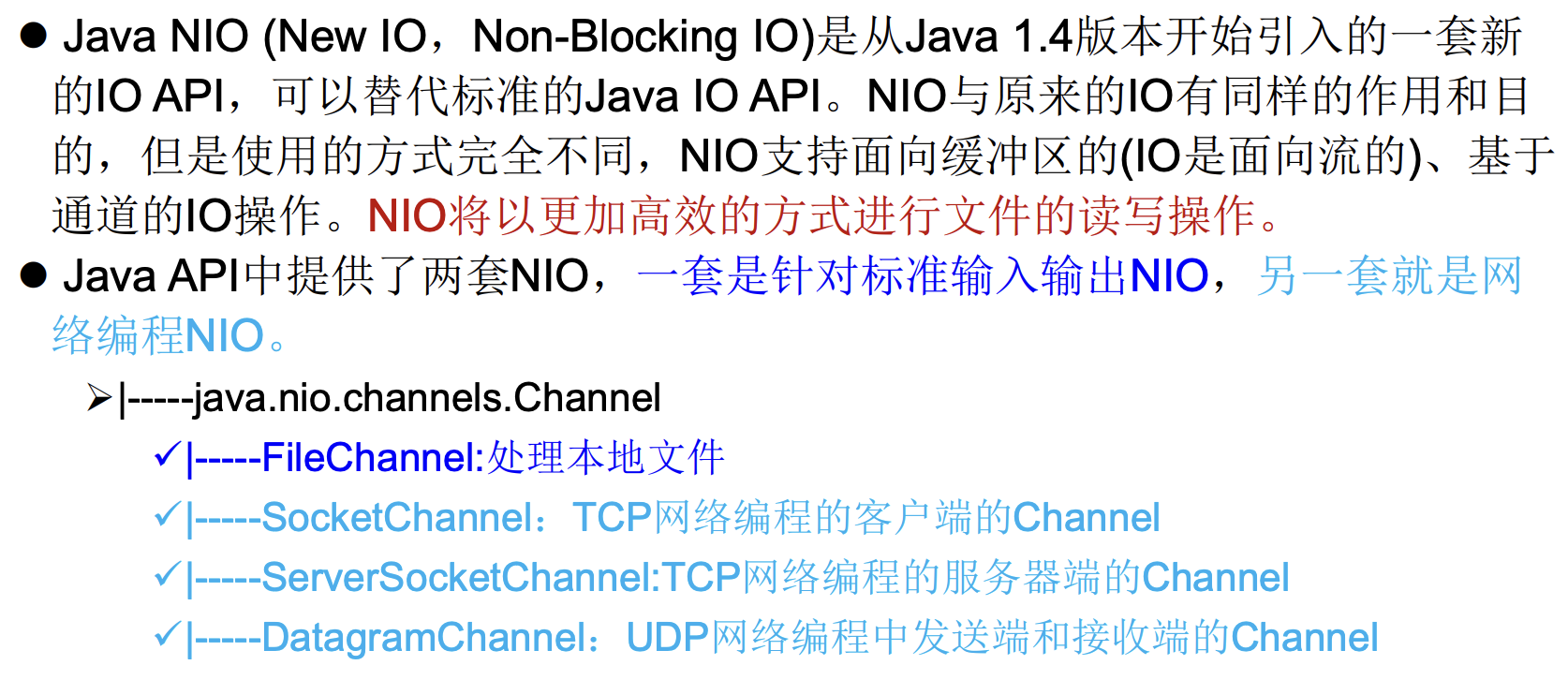
NIO.2

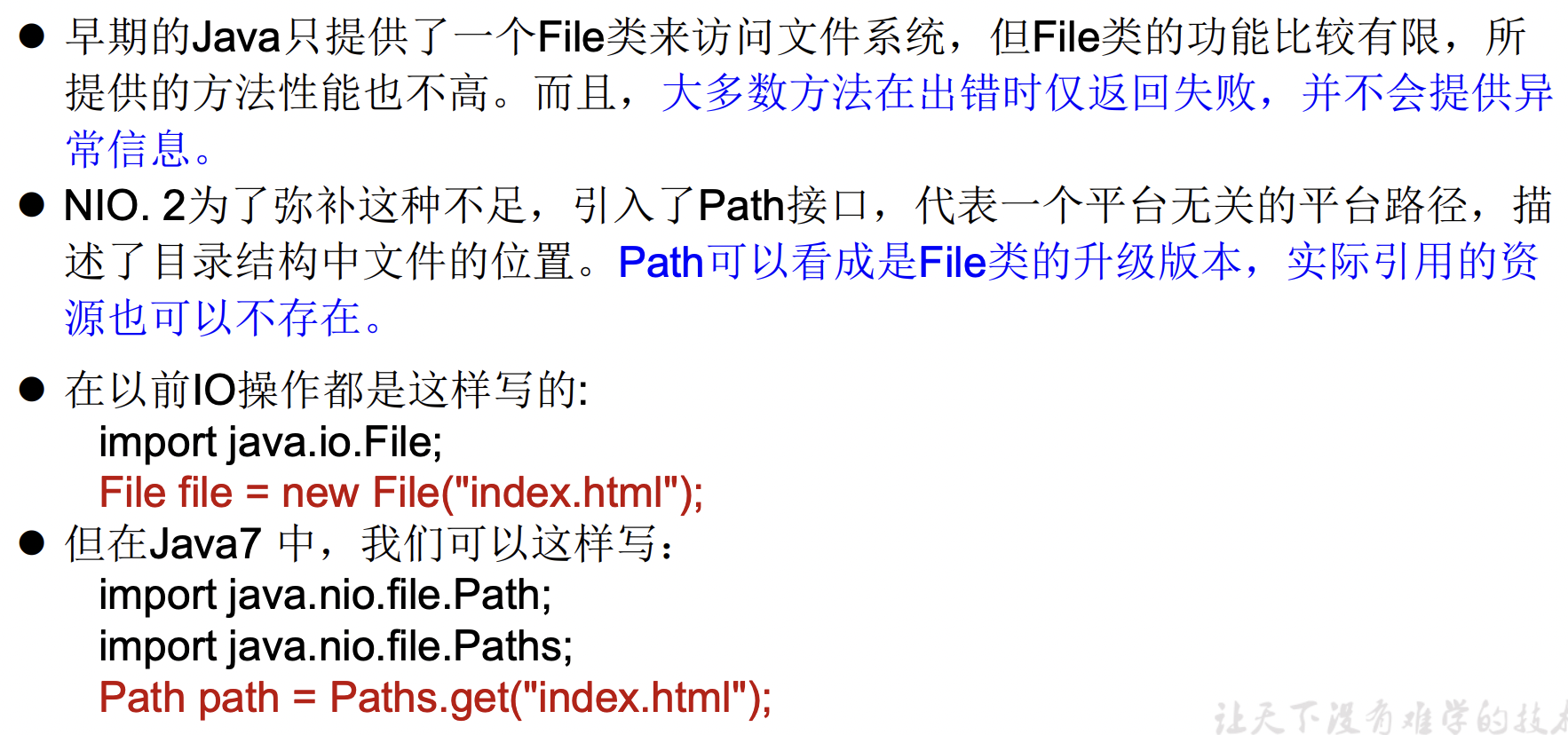




�
